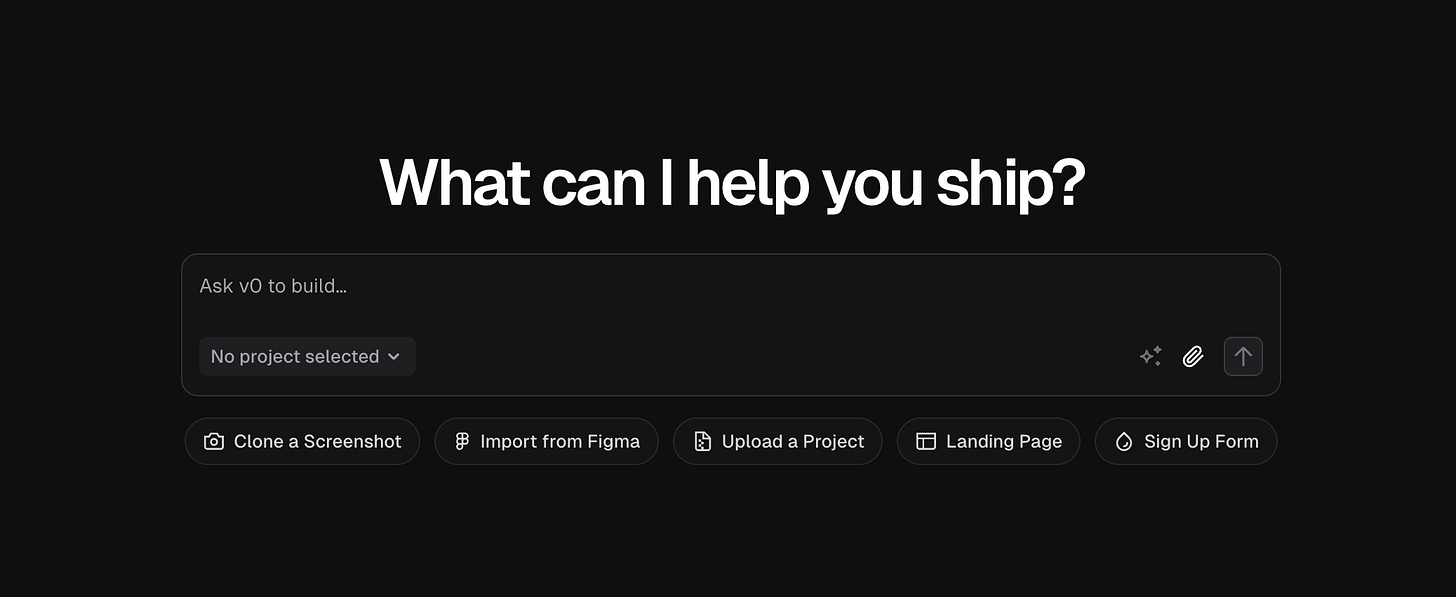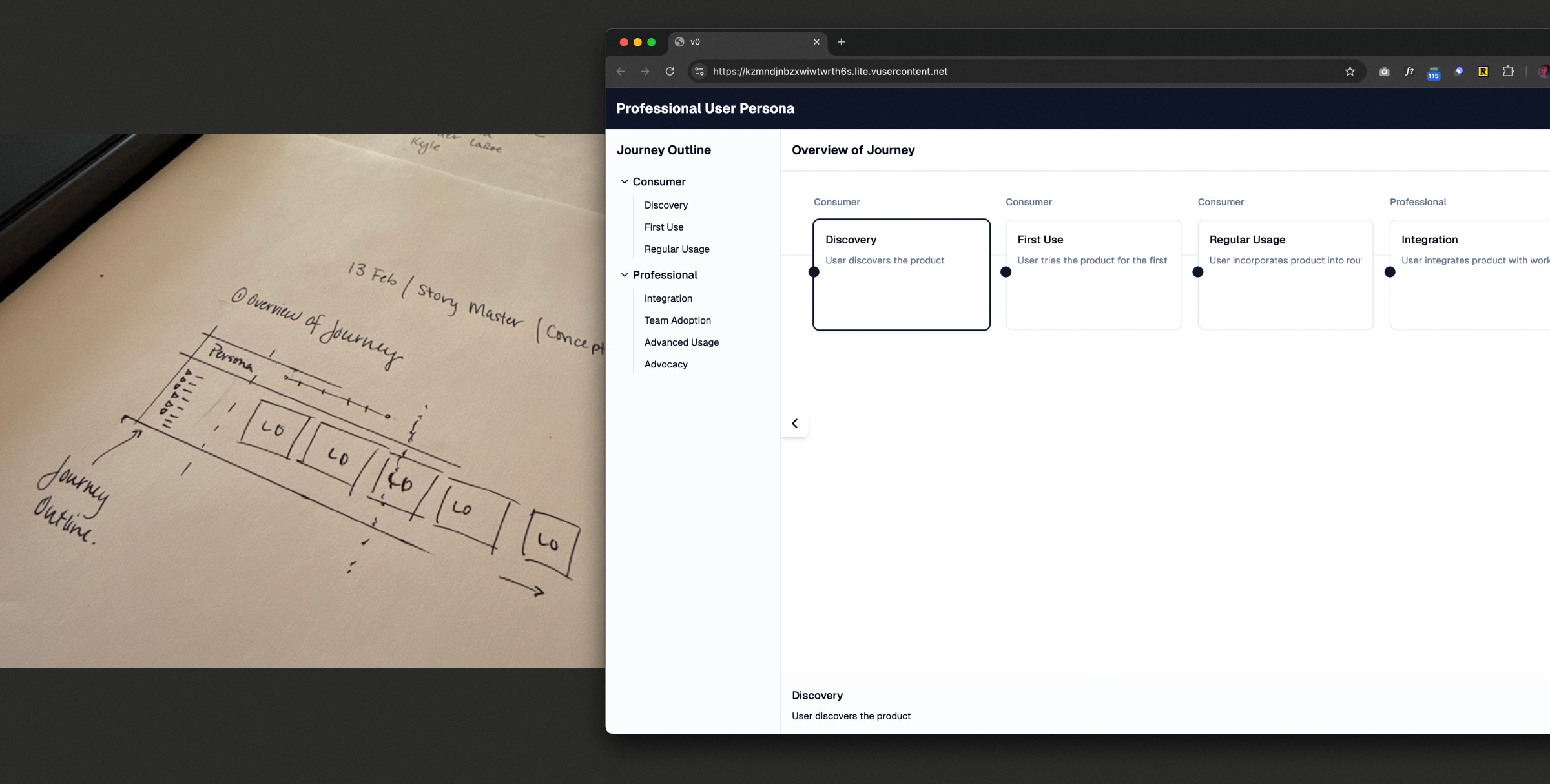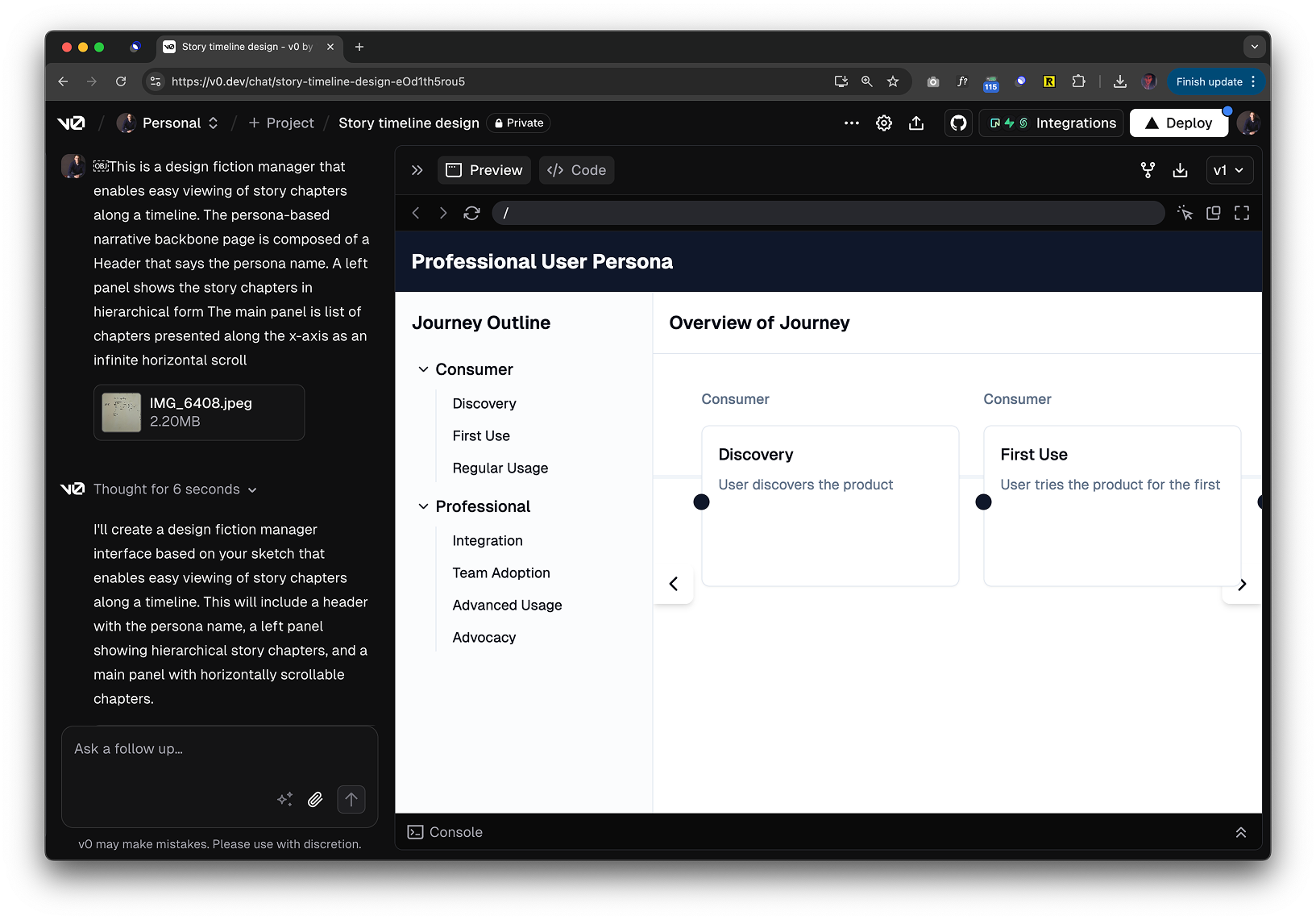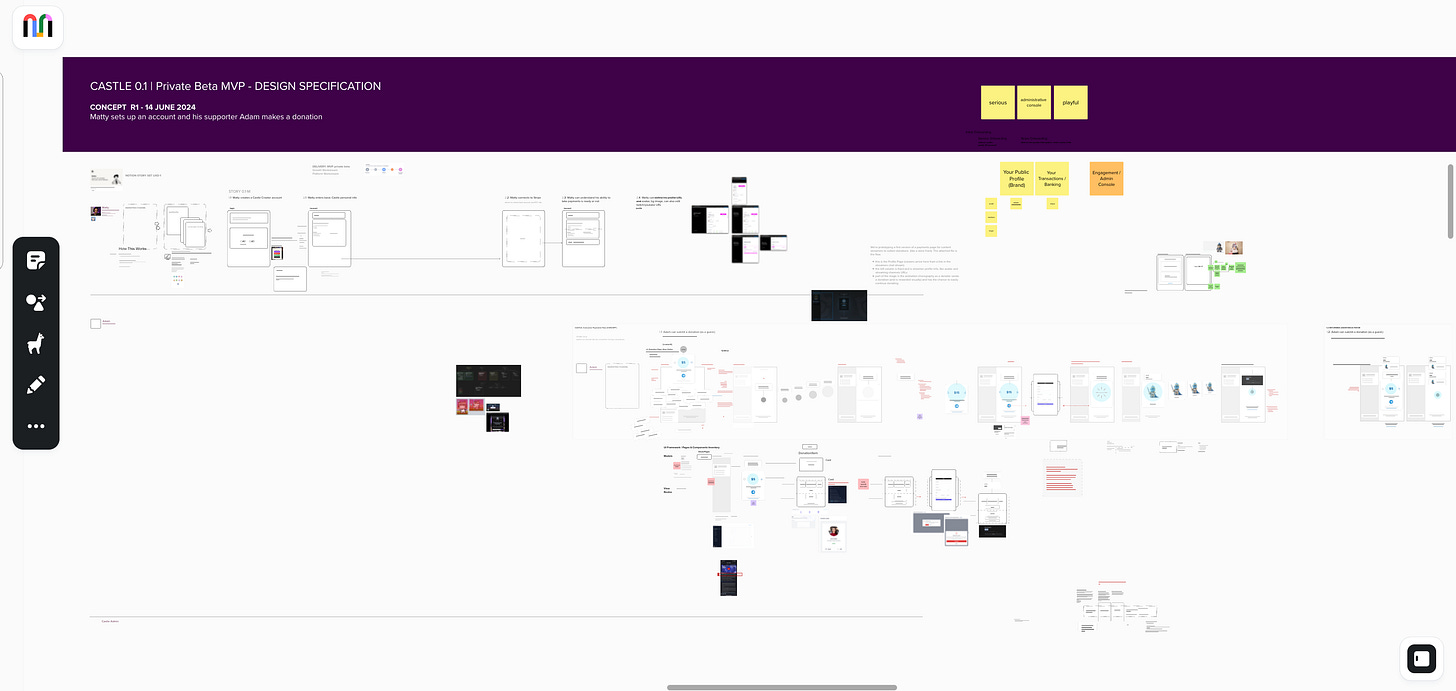From Delivery to Discovery: How AI is Reshaping Design Practice
Why the future belongs to designers who can navigate startup speed and enterprise scale
Intro
AI-powered design tools are transforming the landscape of digital product creation. From prompt-driven development platforms like v0.dev to AI-enhanced collaboration environments like Miro and FigJam, these tools expand what’s possible in early-stage ideation, prototyping, and cross-functional communication.. On one hand, they empower solopreneurs and non-designers to visualize and simulate product ideas with high fidelity and interactivity—without needing deep design or technical expertise.
But for experienced product designers, these tools open up entirely new dimensions of practice. They enable us to think beyond screens and flows, and start shaping the next generation of user experiences—ones that are more adaptive, more responsive, and more deeply human. To keep pace, we need to evolve not just our tools, but our approach—bringing our craft into conversation with the new mediums of LLMs, real-time systems, and intelligent interfaces.
Tools like v0.dev are powerful examples of this shift—they amplify user-centered design practices by helping designers push boundaries, bring complex ideas to life faster, and build interactive, data-rich prototypes that once required weeks of engineering support. They also help bridge the gap between speculative design and functional systems, allowing us to prototype design fictions—linking 'what if' product narratives to working simulations that model behavior and flow. This connection between imagined futures and tangible simulations helps us think through new interaction modalities, from AI-augmented collaboration to adaptive, context-aware interfaces.
This shift moves design practice from static screens and flat flows toward immersive, dynamic simulations. It enhances the designer’s role as a strategic partner in product development—one who prototypes not only the visual experience but the underlying behavior and context of use.
To begin, we’ll look at how different design modes—working inside an enterprise organization versus experimenting with startups or solo projects—shape the way these tools show up in practice. Each mode presents its own constraints and freedoms, and AI tools like v0.dev are starting to collapse the boundaries between them.
Designers often find themselves shifting between different contexts—each with distinct rhythms, constraints, and opportunities for AI-enhanced tools. Understanding these contexts helps determine when and how to integrate tools like v0.dev into your workflow.
Mode 1: Startup or Solo Design Exploration
In startup settings or personal projects, the pace is faster, the constraints are fewer, and the feedback loops are shorter. Tools like v0.dev shine here because they collapse the gap between ideation and implementation. Designers can sketch out an idea, write a structured narrative of the product vision and use that narrative as a living spec for prototyping and development.
We experienced this firsthand while building Castle, a creator support platform currently in private alpha. We began with a narrative describing what we might build, then mapped out the interaction flows to arrive at a working framework. From there, conceptualizing became straightforward. Our backend developer Mark could use the v0.dev-generated UI almost as-is, while our creative director Ryan focused on visual and motion graphics design for individual components which I can then integrate into v0.dev prototypes. We have a tight cadence of breaking down releases into smaller technical sequences that each introduce incremental change.
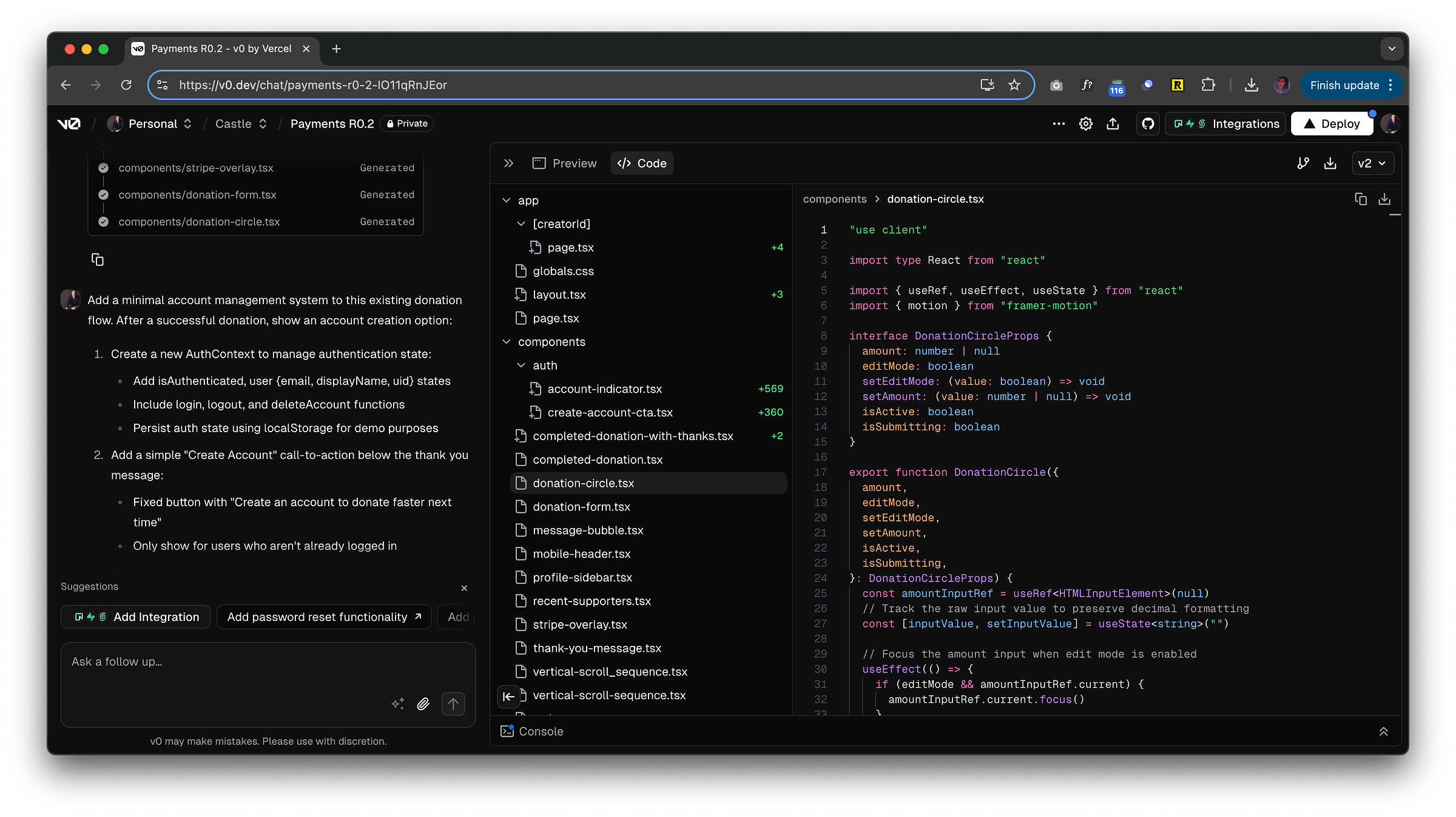
This approach eliminated traditional handoffs—we are co-evolving the product in real-time. Now, as we look toward the next version, we're in discovery mode again. New concepts take shape through narrative elaboration, Mural flows, Notion user stories, and team conversations, with v0.dev ready to help us prototype and test once ideas crystallize.
This mode rewards improvisation, storytelling, and tight loops between design and development. It also invites speculative thinking: what could this be? What’s the fastest way to test that vision with a few real users?
Mode 2: Enterprise Design Systems & Coordination
In an enterprise setting, the scale increases—so does the importance of consistency, coordination, and systems thinking. Design teams are often distributed across multiple products, and prototypes are used not just to test ideas, but to communicate them across functions. Here, narratives become essential tools for bringing order to complexity, helping teams align on user scenarios across distributed product families.
AI-powered tools take on a different role in this context. They promise to help componentize large systems, enforce design language, and simulate how new workflows might affect other parts of a product family. Tools like v0.dev can ingest structured component libraries and reuse design tokens, while collaborative environments like FigJam, Notion, and Miro become planning surfaces that integrate directly with downstream tools.
At RealPage, product designers on my team work across more than a dozen platform and product teams. Each designer navigates shared systems, updates others on in-flight changes, and prototypes in ways that reflect production realities. A speculative redesign might begin with a narrative sketch of scenarios across time, but it quickly needs to conform to our shared visual language, grid systems, accessibility constraints, and architectural dependencies.

We're still in the early stages of exploring how tools like v0.dev fit into this environment, experimenting with two distinct approaches: component-level prototypes and layout frameworks for implementation-focused work, and broader discovery concepting for exploring ideas without immediate implementation intent. We're also exploring how LLMs can help us scale our design fiction practice—using AI to generate scenario variations across different user contexts and business models, then testing these narratives through rapid prototyping.
This creates an interesting tension: in the enterprise, mature tools like Figma support established delivery operations and flexible design thinking, while tools like v0.dev promise to generate more production-ready UI—if teams can tune the machine to work for them. Some designers will always prefer the freedom and fluidity of Figma for early exploration, while others may introduce ideas through v0.dev at the orchestration layer (entire views or flows) or for components demanding specific, novel interactivity.
We're exploring how to bridge these approaches—balancing structured design system rhythms with the expressive possibilities that prompt-driven prototyping enables. Fundamentally, this is about storytelling through simulation: the faster we can create, test, and explore new interactions across multiple contexts, the more human-centered our outcomes become.
AI tools are already helping us speed up some of the negotiation—reducing time spent mocking up variants, clarifying edge cases through realistic simulations, and supporting design/dev conversations with working examples rather than redlines.
Exploring Together
By understanding the shape of your design context, you can better tune how and when to bring in AI tools. Some contexts call for quick tests and expressive leaps; others call for structured modeling and cross-team fluency. In both, the designer’s imagination remains at the center—now with more powerful tools to support it.
This newsletter explores how AI is fundamentally transforming product design—not by replacing human creativity, but by elevating discovery work over delivery, reshaping how design teams create value, and opening new opportunities for designers who cultivate strong design sense within collaborative product teams. Thank you for exploring these changes with me. The future of design is being written through our collective experiments, discoveries, and willingness to explore what's possible when human creativity meets intelligent tools.
What’s Next
In the coming issues, we'll dive deeper into specific design practices and prototyping workflows that are emerging in this new AI-assisted landscape. Expect explorations on:
How to write design narratives as product requirement documents
Bridging Figma, Notion, and v0.dev for dynamic prototyping
Using interactive prototypes to communicate intent—not just visuals
Evolving design systems to support real-time UI generation
Experimenting with new interaction patterns made possible by LLMs
This is a space for experimentation, reflection, and sharing what we're learning as we build. I'd love to hear how these modes show up in your work—and what tools, methods, or questions you're exploring.



